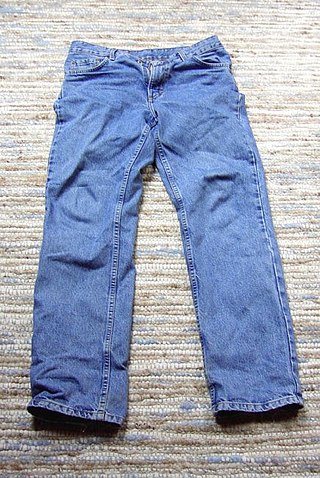
Jeans are a type of pants or trousers made from denim or dungaree cloth. Often the term "jeans" refers to a particular style of trousers, called "blue jeans", with the addition of copper pocket rivets added by Jacob W. Davis in 1871 and patented by Davis and Levi Strauss on May 20, 1873. Prior to the patent, the term "blue jeans" had been long in use for various garments, constructed from blue-colored denim.
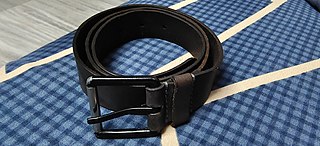
A belt is a flexible band or strap, typically made of leather, plastic, or heavy cloth, worn around the natural waist or near it. The ends of a belt are free; and a buckle forms the belt into a loop by securing one end to another part of the belt, at or near the other end. Often, the resulting loop is smaller than the hips. Belts come in many lengths because of the variety in waist sizes, and most belts can be adjusted at the buckle to suit the wearer's waist.
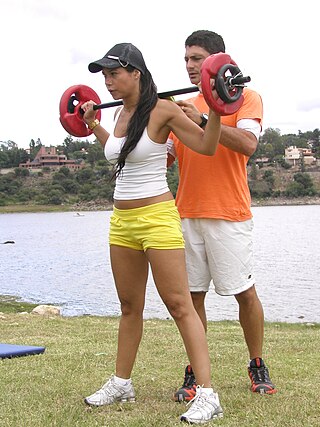
Shorts are a garment worn over the pelvic area, circling the waist and splitting to cover the upper part of the legs, sometimes extending down to the knees but not covering the entire length of the leg. They are called "shorts" because they are a shortened version of trousers, which cover the entire leg, but not the foot. Shorts are typically worn in warm weather or in an environment where comfort and airflow are more important than the protection of the legs.

A safari jacket or bush jacket also known as a “shacket” is a garment originally designed for the purpose of going on safari in the African bush. When paired with trousers or shorts, it becomes a safari suit. A safari jacket is commonly a lightweight cotton drill or lighter poplin jacket, traditionally khaki in color, with a self-belt, epaulets, four or more expandable bellows pockets and often with cartridge loops.
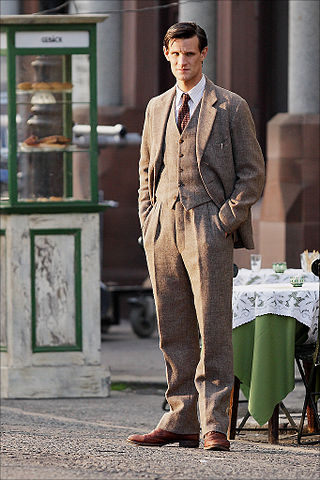
A suit, lounge suit, or business suit is a set of clothes comprising a suit jacket and trousers of identical textiles generally worn with a collared dress shirt, necktie, and dress shoes. A skirt suit is similar, but with a matching skirt instead of trousers. It is currently considered semi-formal wear or business wear in contemporary Western dress codes, however when the suit was originally developed it was considered an informal or more casual option compared to the prevailing clothing standards of aristocrats and businessmen. The lounge suit originated in 19th-century Britain as sportswear and British country clothing, which is why it was seen as more casual than citywear at that time, with the roots of the suit coming from early modern Western Europe formal court or military clothes. After replacing the black frock coat in the early 20th century as regular daywear, a sober one-coloured suit became known as a lounge suit.

Bell-bottoms are a style of trousers that become wider from the knees downward, forming a bell-like shape of the trouser leg.
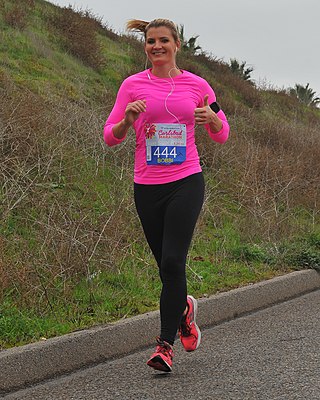
Leggings are several types of leg attire that have varied through the years. Modern usage from the 1960s onwards has come to refer to elastic close-fitting high-rise garments worn over the legs typically by women, such as leg warmers or tights. Usage from the 18th century refers to men's wear usually made of cloth or leather that is wrapped around the leg down to the ankle. In the 19th century, leggings usually referred to infants' leg clothing that were matched with a jacket, as well as leg-wrappings made of leather or wool and worn by soldiers and trappers. Leggings prominently returned to women's fashion in the 1960s, drawing from the form-fitting clothing of dancers. With the widespread adoption of the synthetic fibre Lycra and the rise in popularity of aerobics, leggings came to further prominence in the 1970s and 1980s, and eventually made their way into streetwear. Leggings are a part of the late 2010s into the 2020s athleisure fashion trend of wearing activewear outside sporting activities and in casual settings.

Bondage pants or bondage trousers are trousers with zippers, straps, chains, rings and buckles, giving an appearance of a BDSM style. They come in a variety of colors and patterns; one of the most common patterns being tartan. Bondage pants also come in a variety of styles, including tight or baggy, long, short or Capri.
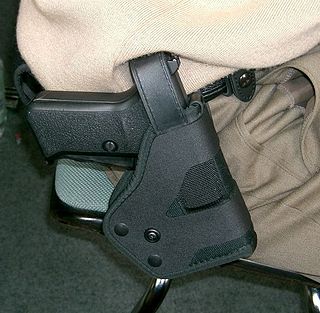
A handgun holster is a device used to hold or restrict the undesired movement of a handgun, most commonly in a location where it can be easily withdrawn for immediate use. Holsters are often attached to a belt or waistband, but they may be attached to other locations of the body. Holsters vary in the degree to which they secure or protect the firearm. Some holsters for law enforcement officers have a strap over the top of the holster to make the handgun less likely to fall out of the holster or harder for another person to grab the gun. Some holsters have a flap over the top to protect the gun from the elements.
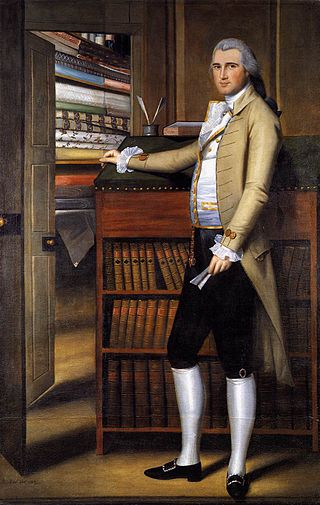
Breeches are an article of clothing covering the body from the waist down, with separate coverings for each leg, usually stopping just below the knee, though in some cases reaching to the ankles. Formerly a standard item of Western men's clothing, they had fallen out of use by the mid-19th century in favour of trousers.
Wide-leg jeans, colloquially called baggy pants, are a style of clothing popular from the early 1980s to the 2010s. And again in the 2020s.

Fashion in the 1990s was defined by a return to minimalist fashion, in contrast to the more elaborate and flashy trends of the 1980s. One notable shift was the mainstream adoption of tattoos, body piercings aside from ear piercing and, to a much lesser extent, other forms of body modification such as branding.

The fashion of the 2000's is often described as a global mash up, where trends saw the fusion of vintage styles, global and ethnic clothing, as well as the fashions of numerous music-based subcultures. Hip-hop fashion generally was the most popular among young people of both sexes, followed by the retro inspired indie look later in the decade.
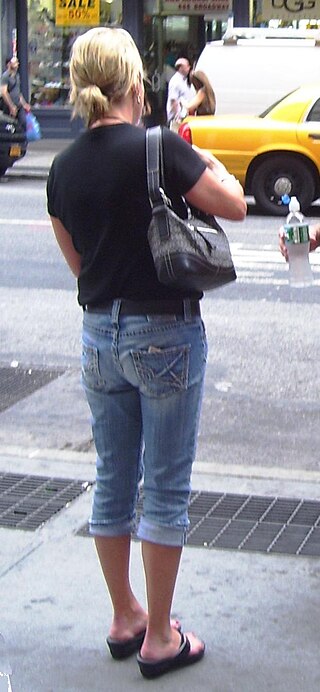
Pedal pushers are calf-length trousers that were popular during the 1950s and the early 1960s. First seen as Knickerbockers or "knickers", they were baggy trousers that extended to or just below the knee and were most commonly fastened with either a button or buckle. Knickerbockers were initially worn by men in the late 19th century and over time became part of women's fashion. Often cuffed and worn tight to the skin, they are related in style to capri pants, and are sometimes referred to as "clam diggers". The name "pedal pushers" originated from the style originally worn by cyclists, because long pants can catch in bicycle chains, but the style quickly became identified with teenage girls.

Carpenter jeans are jeans with many pockets and loops which can be used to carry objects such as tools and are often loose around the leg to be able to accommodate the affixed items. They are often worn by construction workers and carpenters, hence the name, to carry their tools so that their hands can be kept free yet the tools are still easily accessible.

Trousers, slacks, or pants are an item of clothing worn from the waist to anywhere between the knees and the ankles, covering both legs separately. In the United Kingdom, the word pants generally means underwear and not trousers. Shorts are similar to trousers, but with legs that come down only to around the area of the knee, higher or lower depending on the style of the garment. To distinguish them from shorts, trousers may be called "long trousers" in certain contexts such as school uniform, where tailored shorts may be called "short trousers" in the UK.

Underwear, underclothing, or undergarments are items of clothing worn beneath outer clothes, usually in direct contact with the skin, although they may comprise more than a single layer. They serve to keep outer clothing from being soiled or damaged by bodily excretions, to lessen the friction of outerwear against the skin, to shape the body, and to provide concealment or support for parts of it. In cold weather, long underwear is sometimes worn to provide additional warmth. Special types of undergarments have religious significance. Some items of clothing are designed as undergarments, while others, such as T-shirts and certain types of shorts, are appropriate both as underwear and outerwear. If made of suitable material or textile, some underwear can serve as nightwear or swimwear, and some undergarments are intended for sexual attraction or visual appeal.
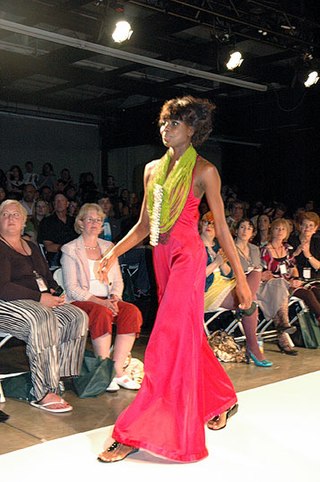
Palazzo pants are long unisex pants cut with a loose, extremely wide leg that flares out from the waist.

Fashion and clothing in the Philippines refers to the way the people of the Philippine society generally dress up at home, at work, travelling and during special occasions.

The fashions of the 2020s represent a departure from 2010s fashion and feature a nostalgia for older aesthetics. They have been largely inspired by styles of the late 1990s to mid-2000s, 1980s, and late 1960s to early 1970s Early in the decade, several publications noted the shortened trend and nostalgia cycle in 2020s fashion. Fashion was also shaped by the COVID-19 pandemic, which had a major impact on the fashion industry, and led to shifting retail and consumer trends.





















